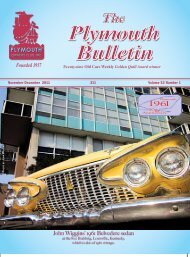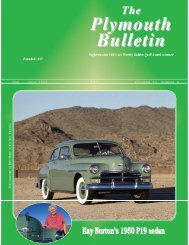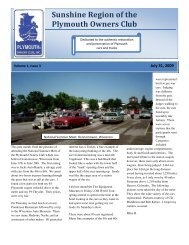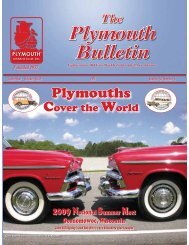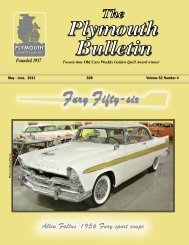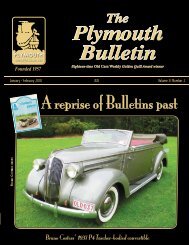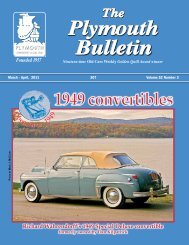Plymouth Owners Club - Plymouth Club
Plymouth Owners Club - Plymouth Club
Plymouth Owners Club - Plymouth Club
- No tags were found...
Create successful ePaper yourself
Turn your PDF publications into a flip-book with our unique Google optimized e-Paper software.
D. BODY1. Sheet metal refers to running board splash pans, radiator apron, and gas tank shield, et al.2. Please circle the location of the defect on the WORKSHEET (RF equals right front)3. Running board pattern incorrectness is most likely to occur on 1928-31 cars where areplacement mat is easier to install.4. Serial no. tag is on the instrument panel of 1928, 1929 models. All other models on rightfront door hinge pillar post.5. Do NOT judge paint or finish (To be done in Category F).6. Poor fit refers to an extra wide gap or uneven gap from top to bottom or front to back.7. Use judgment in all items - add any additional penalty in OTHER spot and give brief detail.E. UNDERCARRIAGE1. Use judgment on cleanliness - if it had been raining just prior to the Meet, then do notpenalize - this item is to penalize the person who never attempts to remove years ofaccumulated mud, grease, rust, etc.2. Color - black is always correct. 1928-1932 cars may have color of fenders on chassis andunder fenders.3. Do NOT judge exhaust system.4. Do NOT judge any leaks (To be done in Category O).5. Excessive holes could mean unplugged holes from an earlier hot rod influence. Also modernshock absorber mounting.6. Excess dents could mean obvious hammer dents on frame from old collision work.F. PAINT1. Do NOT judge wheels, undercarriage, engine compartment (To be done in other categories).2. Metallic paint on pre-1933 <strong>Plymouth</strong>s means ZERO points in this category. White, candyred, pink, purple and very light blues are not authentic colors for pre-1950 models.3. Indicate location of defect, i.e. stripe missing on hood.4. Excessive runs mean more than two.5. Excessive orange peel means over a significant area, i.e. 1/4 of door, etc.6. Poor surface preparation refers to visible sanding or grinder marks, painting over dirt, rust orgrease. Welded cracks are judged in Category D.7. Typical over spray errors can be found on hood handles, hood protectors, trim, serial no. tags,etc.8. Typical sections not painted are doorposts.9. Incorrect color - all <strong>Plymouth</strong> trucks had a light to medium gray color on door sides and jams(visible after opening door).10. Stripe (1933 & 1934 can have 2 or 3 stripes)10



